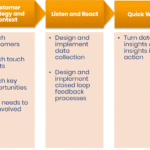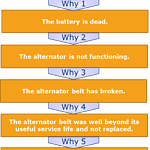Nowhere is this more true than your customer relationships.
It is at the heart of Net Promoter Score … or any customer feedback program for that matter.
I know from experience that it’s easy to believe you have an NPS program operating at or close to maximum effectiveness when you:
- start seeing the customer feedback roll in
- begin to get a better insight into what is important to your customers; and
- implement improvement initiatives (in the case of Cox Automotive, over 100 new initiatives in 18 months)
However, the more I spoke to people and the more I learnt what was possible, the more I realised my optimal performing NPS program “just ain’t so”. So I set out to understand in detail just exactly what went into a high performing Net Promoter program.
In my analysis I identified 121 separate, but important, attributes of a high performing NPS program. At first it seemed too many to be realistic but whenever I tried to remove one I found I just couldn’t – each was important in it’s own right.
What we do know “for sure” is that there are certain key areas that need to be considered and actioned effectively to have a high performing program. In this post I’m not going to go through all of them but I am going to highlight 25 that are particularly critical.
Buy-In
Executive Buy-In: Senior (“C” level buy in to the overall NPS process)
Middle Management engagement: how well do middle management support the process, for they are the silent gatekeepers to the organisation
Internal communication: do all staff really understand the what, why and how of NPS?
Reward & Recognition: Integrating Net Promoter into your R&R planning to ensure long term success.
How effectively do you collect data: Is your data collection comprehensive, reliable and robust. Staff need to believe the data to take it seriously.
Operational Effectiveness
Good governance: sounds boring but governance is critical to NPS success.
Average case response and close times: closing the small loop quickly and effectively.
Documentation standards: nobody wants documentation for documentation sake but you need solid documentation to support the system.
Data segmentation: being able to report on the right data segments underpins continuous improvement.
Data integration: putting the right data in front of the right person at the right time
Initiative Development
Data analysis process and frequency: there is a rhythm to effective data analysis, getting that right is critical.
Project shortlisting process and frequency: identifying and shortlisting the highest value projects.
Project prioritisation process and frequency: having a process to identify the right project to do now.
Quality of customer feedback: distinguishing high quality feedback from low quality feedback, and acting only on high quality.
Business cases: ensuring projects are approved comes down to a solid business case.
Customer Retention
Customer churn reporting: small changes in customer retention have big impacts on business value – you need to track churn.
“At Risk” customer volume: knowing this will help you to target at risk customers
“At Risk” customer value: knowing this will help you to know how much to invest in customer retention.
Process for managing “At Risk” customers: exactly what do you do when you identify an at risk customer?
Customer communication: how, what and when do you communicate with customers for maximum impact.
Customer Growth
Up-Sell capability: sell them more of what they have already purchased.
Cross-Sell capability: sell them new and different products. Research shows a very high take up of new products by promoters.
Online review generation: positive reviews drives sales, it’s as simple as that!
Loyalty Programs: providing the right added value for customers drives long term loyalty.
Referral Programs: you already know your most loyal customers, let them help you market your business.











